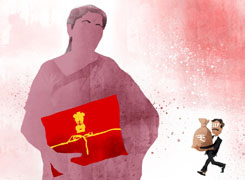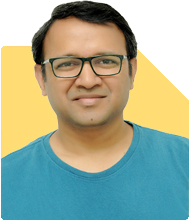
My husband is in a very bad financial trap which we could never overcome. He had a travels business with few cars and a Tempo traveler, but everything was in loan as we could not pay the emi we lost all the vehicles. The monthly EmI we are bound to pay is 1.5 lakhs other than the car loans. We cant even ignore the Emi because, as my husband lost his cibil score we took personal loan using my cibil, my mother and brother in law's cibils and even couple of our friends look loan and gave us. So we have to make sure we pay all those. To pay these EMi my husband took hefty loans from private lenders, one among them is a local rowdy kind of a person. Private loans are for very huge interest, we have payed 8 lakhs interest alone in just 3 months, all that 8 lakhs are also from another private lending person for huge interest. Our debt is increasing tremendously even at this very time iam waiting this question. Everyone started asking us their money back. And that rowdy even came home with few people and used offensive words. I know i cant pay back anything. But alot of family members have given everything thay had to help us and i have to do something to pay them back. We dont have any property or any jwells, we lost everything in playing the interest. Now we have no income at all. We also have a 1 year old child. I am 30 and my husband is 31, we have just started our life but this problem is making us thinking of death. I want us to overcome this for the sake of our daughter and our family. Please shed some good advice. Thank you in advance.
Ans: Your current financial situation is extremely difficult, and you are facing a severe debt trap. This is affecting both your mental health and family life. It is very commendable that despite such pressure, you are seeking a solution rather than giving up. The problem needs immediate attention, and the first thing you must focus on is survival, getting through this phase, and planning a way forward.
It is essential to break the cycle of debt. Your current strategy of taking loans to pay off other loans is not sustainable. The mounting pressure from private lenders, especially those charging high interest, needs to be addressed as a priority.
Immediate Steps to Control Damage
Stop Taking New Loans: This is critical. Do not take further loans to pay EMIs or interest. This will only add to your debt burden and trap you deeper in the cycle. Breaking this habit is the first step to financial recovery.
Prioritize Debt Repayment: Focus on paying off the most critical loans first. Prioritize high-interest private loans, especially the one from the "rowdy" lender, as they are the most dangerous to your situation. You can negotiate with other friends or family members who loaned money to you for an extended time to pay them back later once you clear the higher-risk loans.
Negotiate with Creditors: This might be difficult, but try negotiating with the banks and private lenders for a temporary reduction in EMIs or interest rates. You can explain the current situation and ask for an alternative repayment plan. Lenders will often prefer some recovery over no recovery at all.
Consolidate Debts If Possible: Explore the option of debt consolidation. This would mean combining all your loans into one, usually at a lower interest rate. If you have any formal channels available, you could consolidate loans through a bank or financial institution.
Dealing with Private Lenders
Private lenders, especially those involved in informal lending, can be ruthless. This needs to be addressed tactfully:
Legal Assistance: Consider seeking help from a lawyer, especially if you are being threatened by private lenders. Some actions by these individuals may be illegal, and knowing your legal rights could provide you with protection. There may be legal options to deal with illegal harassment or extremely high-interest loans.
Family Support: Inform your family about the situation with private lenders. Their support will be important, both emotionally and financially, as you work through this crisis.
Generating Immediate Income
Temporary Employment or Side Gigs: Both you and your husband may need to take up any available jobs or side gigs to generate cash flow immediately. Even if it doesn’t cover the entire EMI, any income will help you manage household expenses and avoid further borrowing.
Rent a Room or Space: If you live in a home that has extra space, consider renting out a room to bring in additional income. Every bit of extra money will help during this critical phase.
Freelancing or Online Work: Explore online freelancing or other short-term online jobs that can help you earn some immediate income. The internet has many opportunities that can be explored with little to no investment upfront.
Assessing Your Existing Resources
Tap Into Social Networks: If you haven’t done so yet, you can consider reaching out to extended family and friends. However, be very cautious in borrowing further money. Instead, ask if they can support you with ideas or resources to help you generate more income.
Selling Any Non-Essential Assets: Though you have mentioned losing all your properties and jewelry, double-check for any non-essential household items or assets that can be sold or mortgaged temporarily to raise cash for repayments.
Developing a Financial Plan
Seek Help from a Certified Financial Planner: In a situation like this, a Certified Financial Planner (CFP) can help you restructure your debt and create a plan to manage and reduce it. A CFP will assess your total debt, income, and expenses and help you devise a realistic strategy. There might also be debt settlement options, but this depends on your lender’s willingness to negotiate.
Monthly Budget: Create a strict monthly budget with only necessary expenses. Cut out all non-essential spending, even if it’s small. Every rupee saved can be put toward repaying debt.
Emotional and Mental Well-being
It’s important to remember that mental health is a priority in difficult situations like this. Financial stress can severely impact your health and relationships. Ensure that you and your husband stay mentally strong for the sake of your daughter.
Talk to Family and Friends: Don’t keep the financial stress to yourself. Talk to trusted family members and friends about your emotional struggles. Their support will help you deal with the crisis better.
Counseling and Support Groups: If the burden feels too heavy, consider seeking counseling. There are several financial crisis support groups where people can discuss their problems openly and receive both advice and emotional comfort.
Avoiding Common Pitfalls
Stay Away from Quick-Fix Solutions: Many people in debt fall for schemes that promise easy money, but these often worsen the situation. Stay away from betting, lotteries, or high-risk investments. The focus should be on reducing debt, not trying to gamble out of it.
Don’t Compromise on Essentials: While paying back debts is important, do not compromise on your child’s or family’s basic needs such as food, healthcare, or education. These expenses are crucial for your long-term well-being and stability.
Final Insights
Your situation is overwhelming, but taking small, controlled steps can help you regain stability. The key is to stop further borrowing and reduce your high-interest loans as quickly as possible. It will require discipline, hard work, and sacrifice. Your family, especially those who understand your struggles, can be your best support.
Keep hope alive. Focus on protecting your family and future, especially for the sake of your daughter. You are in a difficult phase, but this can be overcome with proper planning and strong mental strength.
Stay strong and take each step with confidence that things will eventually improve.
Best Regards,
K. Ramalingam, MBA, CFP,
Chief Financial Planner,
www.holisticinvestment.in
https://www.youtube.com/@HolisticInvestment


























